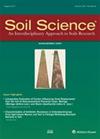Validating plutonium-239+240 as a novel soil redistribution tracer – a comparison to measured sediment yield
4区 农林科学
Q2 Agricultural and Biological Sciences
引用次数: 0
Abstract
Abstract. Quantifying soil redistribution rates is a global challenge addressed with direct sediment measurements (e.g. traps), models, and isotopic, geochemical, and radionuclide tracers. The isotope of plutonium, namely 239+240Pu, is a relatively new soil redistribution tracer in this challenge. Direct validation of 239+240Pu as a soil redistribution tracer is, however, still missing. We used a unique sediment yield time series in southern Italy, reaching back to the initial fallout of 239+240Pu to verify 239+240Pu as a soil redistribution tracer. Distributed soil samples (n=55) were collected in the catchment, and at undisturbed reference sites (n=22), 239+240Pu was extracted, measured with inductively coupled plasma mass spectrometry (ICP-MS), and converted to soil redistribution rates. Finally, we used a generalized additive model (GAM) to regionalize soil redistribution estimates for the catchment. For the catchment sites, mean 239+240Pu inventories were significantly reduced (16.8 ± 10.2 Bq m−2) compared to the reference inventory (40.5 ± 3.5 Bq m−2), indicating the dominance of erosion. Converting these inventory losses into soil erosion rates resulted in an average soil loss of 22.2 ± SD 7.2 t ha−1 yr−1. The uncertainties of the approach stemmed mainly from the high measurement uncertainties of some low-activity samples where samples have been bulked over depth. Therefore, we recommend taking incremental soil samples and extracting larger soil volumes (∼ 20 g). The geographic coordinates and the flow accumulation best described the spatial pattern of erosion rates in the GAM model. Using those predictors to upscale Pu-derived soil redistribution rates for the entire catchment resulted in an average on-site loss of 20.7 t ha−1 yr−1, which corresponds very well to the long-term average sediment yield of 18.7 t ha−1 yr−1 measured at the catchment outlet and to 137Cs-derived soil redistribution rates. Overall, this comparison of Pu-derived soil redistribution rates with measured sediment yield data validates 239+240Pu as a suitable retrospective soil redistribution tracer.验证钚-239+240作为一种新的土壤再分配示踪剂-与测量的沉积物产量的比较
摘要土壤再分配速率的量化是一项全球性挑战,可通过直接沉积物测量(如捕集器)、模型以及同位素、地球化学和放射性核素示踪剂来解决。钚的同位素,即239+240Pu,是该挑战中相对较新的土壤再分配示踪剂。然而,239+240Pu作为土壤再分配示踪剂的直接验证仍然缺失。我们在意大利南部使用了一个独特的沉积物产量时间序列,追溯到239+240Pu的初始沉降,以验证239+240Pu作为土壤再分配示踪剂。收集集水区分布的土壤样品(n=55),在未受干扰的参考点(n=22)提取239+240Pu,用电感耦合等离子体质谱(ICP-MS)测定,并转化为土壤再分配率。最后,我们使用广义加性模型(GAM)对流域土壤再分配估算进行区划。与参考库存量(40.5±3.5 Bq m−2)相比,流域平均239+240Pu库存量(16.8±10.2 Bq m−2)显著减少,表明侵蚀占主导地位。将这些库存损失转化为土壤侵蚀速率,平均土壤流失量为22.2±SD 7.2 t / h - 1年- 1。该方法的不确定度主要源于一些低活度样品的高测量不确定度,其中样品已在深度上膨胀。因此,我们建议增加土壤样品并提取更大的土壤体积(~ 20 g)。在GAM模型中,地理坐标和水流累积最能描述侵蚀速率的空间格局。利用这些预测因子对整个流域的土壤再分配率进行估算,结果表明现场平均损失为20.7 t ha - 1 yr - 1,这与在流域出口测量的长期平均产沙量18.7 t ha - 1 yr - 1和137cs导出的土壤再分配率非常吻合。总的来说,这种由pu衍生的土壤再分配率与测量的产沙量数据的比较验证了239+240Pu是一种合适的回顾性土壤再分配示踪剂。
本文章由计算机程序翻译,如有差异,请以英文原文为准。
求助全文
约1分钟内获得全文
求助全文
来源期刊

Soil Science
农林科学-土壤科学
CiteScore
2.70
自引率
0.00%
发文量
0
审稿时长
4.4 months
期刊介绍:
Cessation.Soil Science satisfies the professional needs of all scientists and laboratory personnel involved in soil and plant research by publishing primary research reports and critical reviews of basic and applied soil science, especially as it relates to soil and plant studies and general environmental soil science.
Each month, Soil Science presents authoritative research articles from an impressive array of discipline: soil chemistry and biochemistry, physics, fertility and nutrition, soil genesis and morphology, soil microbiology and mineralogy. Of immediate relevance to soil scientists-both industrial and academic-this unique publication also has long-range value for agronomists and environmental scientists.
 求助内容:
求助内容: 应助结果提醒方式:
应助结果提醒方式:


